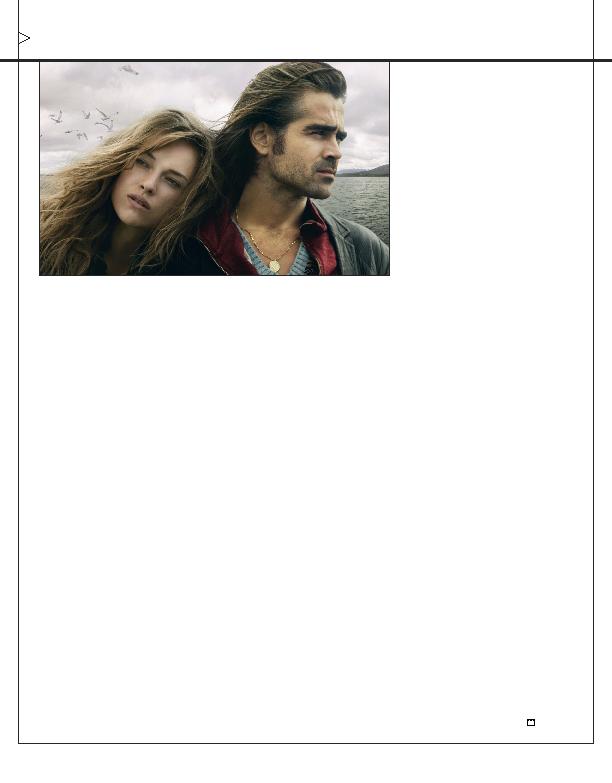
Well, Ondine does just that by presenting a
fairy tale through a postmodern lens --
questions and all. The project started in
2007 when screenwriter-director Neil Jor-
dan was in Hollywood prepping for a stu-
dio film when the writers' strike derailed it.
With no sense of when the strike would
end, Jordan returned to his home in Ireland
to work on a script he'd been thinking
about for a long time. "I had that image of
a fisherman pulling a girl out of his net,"
Jordan recalls, "and I just wanted to see
where this would go. I knew I wanted to tell
a fairy tale without any special effects or
any elements of what you would tradition-
ally think of as magic."
Ondine (Alicja Bachleda) out of one of his
nets. As the film progresses, it's debatable as
to whether or not she is a mermaid. Syracuse
takes her home, where magical things may
or may not start happening. He tells this
story to his daughter, Annie (Alison Barry),
who may or may not believe the fantastical
tale at hand.
you find in real life the archetypes found in
fairy tales? To his surprise, combining ele-
ments from real life and fairy tales turned out
wife, Maura (Dervla Kirwan), became a sort
of Evil Witch in the story, and Annie became
the curious child who serves as the skeptical
voice of the author. In fact, Jordan feels that
writing Annie helped the script really take
shape. "She was one of these kaleidoscopes
through which you can see things in a dif-
ferent light," he says. "It helps that the char-
acter is 10 years old, so [she] can easily
suspend disbelief when she needs to and still
be very realistic and wise when she needs to
as well."
believe in making page-count goals, how-
ever. "If a story is flowing it flows, and if it
doesn't flow then it doesn't flow," Jordan
says. "There seems to be very little I can do
about it. Sometimes, characters are just very
unwilling to come alive and speak to you. If
the character is alive, suddenly the dialogue
flows and your instincts just know what
should happen next. If I'm forcing it, it's gen-
erally a bad thing. I generally have to wait
and let the story speak to me."
grounded in reality. He explains, "I wanted a
realistic portrait of a small fishing town [to
explore] people living their lives the way
they do nowadays. They're divorced, they
have problems with their children, they have
and some are not."
win custody of Annie. But, as we know, drama
is critical and our hero must choose between
succumbing to his past, represented by Maura,
or embracing what his future could hold, rep-
resented by Ondine and the town priest.
"When I started writing this, I didn't know the
character of the priest would be there," Jordan
says. "I just thought it would be fun to have
Syracuse in a town where they don't even have
that language for AA and 12 steps, so he forces
the priest to be his AA buddy in the confes-
sional. But then Maura wants to bring him
back into his old life, so she does that old Irish
thing of giving him a drink. And once she's
done that, she knows she's got him back into
that mess he's been in forever."
dramatic question that Jordan felt would
make or break his script. "I'm writing this
fairy tale that turns out to have all of its basis
in reality," he says. "The whole thing turns
out to have a realistic explanation. But then
I wondered, if you tell a fairy tale successfully
enough, and then you reveal to the audience
that it wasn't a fairy tale, will they be angry?
Will they feel cheated? Will they feel manip-
ulated in some way?" As with the fisherman
pulling a girl from the sea, Jordan points to
another image to answer this question. Late
in the film, Ondine is sitting on a rock with
the sun beating down on her. We see her
shadow on another rock, on which she
seems to have a tail -- until it's revealed to be
a piece of driftwood. "If she hadn't moved
her legs it would've kept looking like a tail,
but she moves her legs and it's a piece of
driftwood," Jordan says. "It was that kind of
movie. It's a particularly Irish story."
how, when and even if people choose to ex-
amine their own lives and the lives of oth-
ers through a fantasy filtered point of view.
"It all comes down to how certain events
are viewed," Jordan says, "When Syracuse
pulls her out, if she doesn't come alive it's
a horror story, and if she does then it's a
fairy tale -- simple as that, really. I just had
that basic image and as a writer you have to
ask what this image is trying to tell you and
where does it want to go. That's what the
script was about in the end."